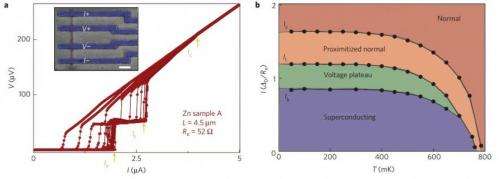A counterintuitive phenomenon discovered: The coexistence of superconductivity with dissipation

For his doctoral dissertation in the Goldman Superconductivity Research Group at the University of Minnesota, Yu Chen, now a postdoctoral researcher at UC Santa Barbara, developed a novel way to fabricate superconducting nanocircuitry. However, the extremely small zinc nanowires he designed did some unexpected—and sort of funky—things.
Chen, along with his thesis adviser, Allen M. Goldman, and theoretical physicist Alex Kamenev, both of the University of Minnesota, spent years seeking an explanation for these extremely puzzling effects. Their findings appear this week in Nature Physics.
"We were determined to figure out how we could reconcile the strange phenomena with the longstanding rules governing superconductivity," said lead author Chen. "The coexistence of superconductivity with dissipation, which we observed, is counterintuitive and bends the rules as we know them."
Typically superconductivity and dissipation are thought to be mutually exclusive because dissipation, a process in thermodynamic systems whereby electric energy is transformed into heat, is a feature of a normal—versus a superconductive—state.
"But we discovered that superconductivity and dissipation can coexist under rather generic conditions in what appears to be a universal manner," Chen said.
After long and careful work, which involved both experimental and theoretical efforts, the researchers found an explanation that fits. Behind all of the observed phenomena is a peculiar nonequilibrium state of quasiparticles—electron-like excitations that formed in the nanowires Chen designed.
The quasiparticles are created by phase slips. In a superconductive state, when supercurrent flows through the nanowire, the quantum mechanical function describing the superconductivity of the wire evolves along the length of the wire as a spiral shaped like a child's Slinky toy. From time to time, one of the revolutions of the spiral contracts and disappears altogether. This event is called a phase slip. This quirk generates quasiparticles, giving rise to a previously undiscovered voltage plateau state where dissipation and superconductivity coexist.
"The most significant achievement was making the nanowires smaller and cooler than anyone had done previously," Kamenev said. "This allowed the quasiparticles to travel through the wire faster and avoid relaxation. This leads to a peculiar nonthermal state, which combines properties of a superconductor and a normal metal at the same time."
In addition to discovering this unique phenomenon, the team also found another heretofore-unseen property in the voltage plateau. When a magnetic field is turned on in the voltage plateau state, rather than shrinking the superconducting region, which is what would usually occur, the superconducting area expands and is enhanced.
"This is an unexpected property of very small nanowires," said Goldman.
This state appears to be universal for ultra-small superconducting circuitry like Chen's, which features ideal contacts between the nano-elements and the leads. Such nanoscale superconductors may be key components in future superconducting computer systems.
"Our findings demonstrate that superconducting nanocircuits can be used as a simple, but rather generic platform to investigate nonequilibrium quantum phenomena," Chen concluded.
"Now we need to explore the parameters of nanowires that give rise to the effect and those that don't," Goldman said. "We also need to examine the behavior of wires of different lengths and different materials in order to further define the parameters."
More information: Dissipative superconducting state of non-equilibrium nanowires, Nature Physics, DOI: 10.1038/nphys3008
Journal information: Nature Physics
Provided by University of California - Santa Barbara





















